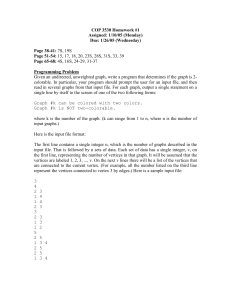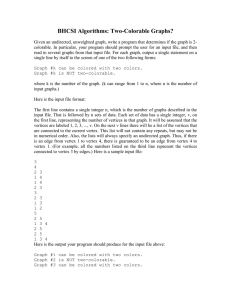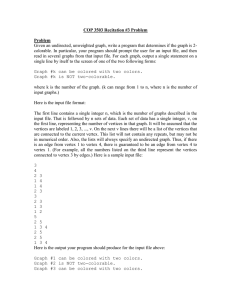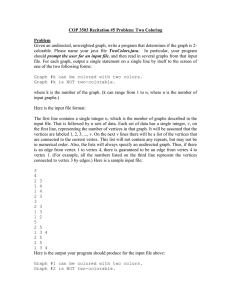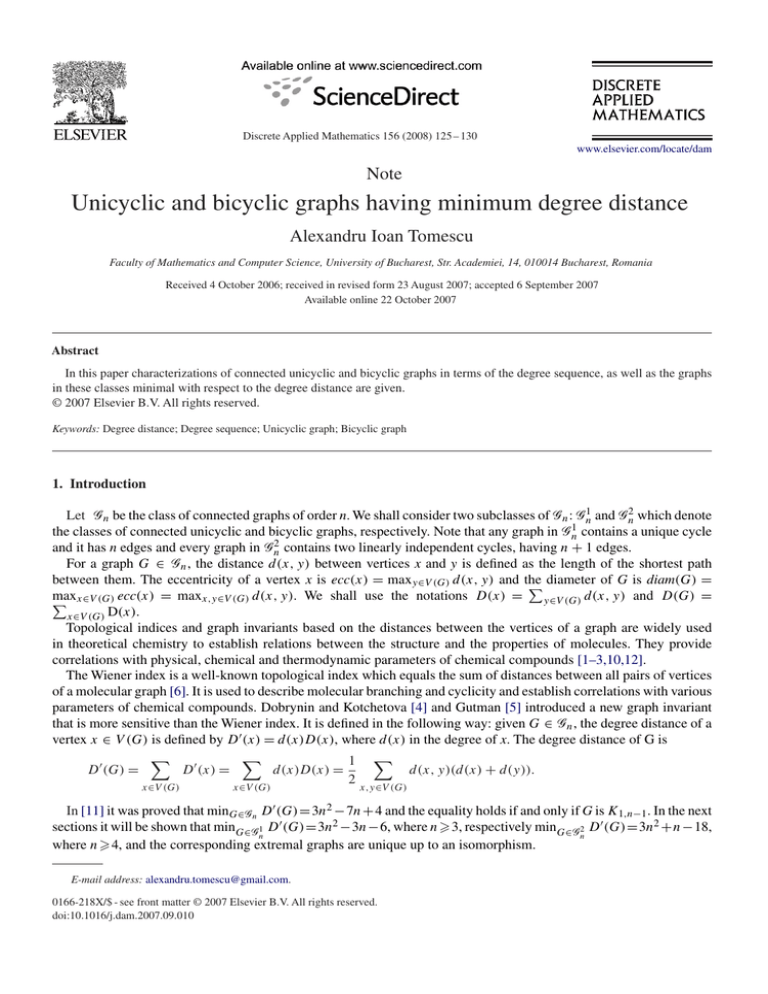
Discrete Applied Mathematics 156 (2008) 125 – 130
www.elsevier.com/locate/dam
Note
Unicyclic and bicyclic graphs having minimum degree distance
Alexandru Ioan Tomescu
Faculty of Mathematics and Computer Science, University of Bucharest, Str. Academiei, 14, 010014 Bucharest, Romania
Received 4 October 2006; received in revised form 23 August 2007; accepted 6 September 2007
Available online 22 October 2007
Abstract
In this paper characterizations of connected unicyclic and bicyclic graphs in terms of the degree sequence, as well as the graphs
in these classes minimal with respect to the degree distance are given.
© 2007 Elsevier B.V. All rights reserved.
Keywords: Degree distance; Degree sequence; Unicyclic graph; Bicyclic graph
1. Introduction
Let Gn be the class of connected graphs of order n. We shall consider two subclasses of Gn : G1n and G2n which denote
the classes of connected unicyclic and bicyclic graphs, respectively. Note that any graph in G1n contains a unique cycle
and it has n edges and every graph in G2n contains two linearly independent cycles, having n + 1 edges.
For a graph G ∈ Gn , the distance d(x, y) between vertices x and y is defined as the length of the shortest path
between them. The eccentricity of a vertex x is ecc(x) = maxy∈V (G) d(x, y) and the
diameter of G is diam(G) =
max
ecc(x)
=
max
d(x,
y).
We
shall
use
the
notations
D(x)
=
x∈V
(G)
x,y∈V
(G)
y∈V (G) d(x, y) and D(G) =
x∈V (G) D(x).
Topological indices and graph invariants based on the distances between the vertices of a graph are widely used
in theoretical chemistry to establish relations between the structure and the properties of molecules. They provide
correlations with physical, chemical and thermodynamic parameters of chemical compounds [1–3,10,12].
The Wiener index is a well-known topological index which equals the sum of distances between all pairs of vertices
of a molecular graph [6]. It is used to describe molecular branching and cyclicity and establish correlations with various
parameters of chemical compounds. Dobrynin and Kotchetova [4] and Gutman [5] introduced a new graph invariant
that is more sensitive than the Wiener index. It is defined in the following way: given G ∈ Gn , the degree distance of a
vertex x ∈ V (G) is defined by D (x) = d(x)D(x), where d(x) in the degree of x. The degree distance of G is
1 D (G) =
D (x) =
d(x)D(x) =
d(x, y)(d(x) + d(y)).
2
x∈V (G)
x∈V (G)
x,y∈V (G)
In [11] it was proved that minG∈Gn D (G) = 3n2 − 7n + 4 and the equality holds if and only if G is K1,n−1 . In the next
sections it will be shown that minG∈G1 D (G)=3n2 −3n−6, where n3, respectively minG∈G2 D (G)=3n2 +n−18,
n
n
where n 4, and the corresponding extremal graphs are unique up to an isomorphism.
E-mail address: alexandru.tomescu@gmail.com.
0166-218X/$ - see front matter © 2007 Elsevier B.V. All rights reserved.
doi:10.1016/j.dam.2007.09.010
126
A. Ioan Tomescu / Discrete Applied Mathematics 156 (2008) 125 – 130
2. Preliminary results
It is well known [7,9], that natural numbers d1 d2 · · · dn 1 are the degrees of the vertices of a tree if and only
if ni=1 di = 2n − 2. In the same spirit, the next two lemmas characterize connected unicyclic and bicyclic graphs by
their degree sequence.
Lemma 2.1. Let n 3. The integers d1 d2 · · · dn 1 are the degrees of the vertices of a graph G ∈ G1n if and
only if
n
(i)
i=1 di = 2n;
(ii) at least three of them are greater than or equal to 2.
Proof. Suppose that G ∈ G1n . If G has m edges, its cyclomatic number is m − n + 1 = 1, hence m = n and (i) is verified.
Additionally, (ii) is also verified since the vertices of the unique cycle have the degrees greater than or equal to 2.
The sufficiency will be proved by induction on n. For n = 3 we deduce that d1 = d2 = d3 = 2 and the cycle C3 ∈ G13 is
the only graph having this degree sequence. Suppose that n 4 and that the statement is true for all n n − 1. If dn 2
1
it follows that d1 =
dn2 = · · · = dn = 2 and the cycle Cn ∈ Gn has these degrees. Otherwise, one has dn = 1. If di 2 for all
1 i n−1 then i=1 di 2n−1, which contradicts the hypothesis. Hence there exists a maximal index j, 1 j n−1
such that dj 3, dj +1 2 and d1 · · · dj −1 dj > dj +1 · · · dn = 1. We have n−1
k=1,k=j dk + (dj − 1) = 2(n − 1)
and at least three numbers of the sequence d1 , d2 , . . . , dj −1 , dj − 1, dj +1 , . . . , dn−1 are greater than or equal to 2. By
the induction hypothesis there exists a graph G1 ∈ G1n−1 having this degree sequence. By adding a new vertex, joined
by an edge with the vertex of degree dj − 1 of G1 , we get a connected unicyclic graph of order n having the degree
sequence d1 , . . . , dn , where dn = 1. Lemma 2.2. Let n4. The integers d1 d2 · · · dn 1 are the degrees of the vertices of a graph G ∈ G2n if and
only if
n
(i)
i=1 di = 2n + 2;
(ii) at least four of them are greater than or equal to 2;
(iii) d1 n − 1.
Proof.
Let G ∈ G2n . Because G has the cyclomatic number m − n + 1 = 2, it follows that m = n + 1, hence
n
i=1 di = 2n + 2. Two cycles contain together at least four vertices of degrees greater than or equal to 2 and (ii) is
verified. Also, d1 |V (G)| − 1 = n − 1.
The sufficiency will be shown also by induction on n. For n = 4 we deduce that d1 = d2 = 3 and d3 = d4 = 2. In this
case, C4 + e ∈ G24 is the only graph having this degree sequence. Let n5 and suppose that the statement is true for all
n n−1. If dn 2 then the only possibilities are: (a) d1 =4, d2 =d3 =· · ·=dn =2 and (b) d1 =d2 =3, d3 =d4 =· · ·=dn =2.
In the first case, any graph consisting of two cycles Cp and Cn+1−p having a common vertex (3 p n − 2) is in
G2n and has the above mentioned degree sequence. In the second case, any cycle with a chord Cn + e has this degree
sequence.
The remaining case is dn =1. If d1 =n−1 then the only possibilities are d1 =n−1, d2 =d3 =d4 =d5 =2, d6 =· · ·=dn =1
and d1 = n − 1, d2 = 3, d3 = d4 = 2, d5 = · · · = dn = 1. These degree sequences have unique realizations in G2n ,
namely K1,n−1 plus two vertex disjoint edges and
two edges having a common extremity, respectively. Suppose that
d1 n − 2. If di 2 for each 1 i n − 1 then ni=1 di 2n − 1, a contradiction. By the same reasoning as above, we
can find a maximal index j, 1 j n − 1 such that dj 3, dj +1 2 and d1 · · · dj −1 dj > dj +1 · · · dn = 1.
At least four numbers of the sequence d1 , . . . , dj −1 , dj − 1, dj +1 , . . . , dn−1 are greater than or equal to 2, d1 n − 2
2
and n−1
k=1,k=j dk + (dj − 1) = 2(n − 1) + 2. Applying the induction hypothesis, there exists a graph G2 ∈ Gn−1 having
this degree sequence. By adding a new vertex, joined by an edge with the vertex of degree dj − 1 of G2 we obtain a
connected bicyclic graph of order n having the degree sequence d1 , . . . , dn , where dn = 1. We note that a slightly different characterization was obtained for unicyclic and bicyclic graphs by Schocker in [8].
However, it is not convenient for our approach.
A. Ioan Tomescu / Discrete Applied Mathematics 156 (2008) 125 – 130
127
Let xi denote the number of vertices of degree i of G ∈ Gn , for 1 i n − 1. If d(v) = k then D(v)k + 2(n − k −
1) = 2n − k − 2 and the equality holds if and only if ecc(x) 2. Consequently,
D (G) =
d(v)D(v)
n−1
kx k (2n − k − 2),
k=1
v∈V (G)
where the equality holds if and only if diam(G)2.
By denoting as in [11]
F (x1 , . . . , xn−1 ) =
n−1
kx k (2n − k − 2),
k=1
we will find the minimum of F (x1 , . . . , xn−1 ) over all natural numbers x1 , . . . , xn−1 0 satisfying the conditions in
Lemmas 2.1 and 2.2.
Rewriting Lemmas 2.1 and 2.2 in terms of the above notations, yields:
Corollary 2.3. Let n 3. The integers x1 , . . . , xn−1 0 are the multiplicities of the degrees of a graph G ∈ G1n if and
only if:
(i)
n−1
(ii)
n−1
i=1 xi
= n;
i=1 ix i
= 2n;
(iii) x1 n − 3.
Corollary 2.4. Let n 4. The integers x1 , . . . , xn−1 0 are the multiplicities of the degrees of a graph G ∈ G2n if and
only if:
(i)
n−1
(ii)
n−1
i=1 xi
= n;
i=1 ix i
= 2n + 2;
(iii) x1 n − 4.
Denote by 1 and 2 the sets of vectors (x1 , . . . , xn−1 ) where x1 , . . . , xn−1 are non-negative integers satisfying the
conditions (i)–(iii) in Corollaries 2.3 and 2.4, respectively.
Let G ∈ Gn with the associated multiplicities of the degrees (x1 , . . . , xn−1 ) and let m 2, p > 0, m + p n −
2, xm 1, xm+p 1. Now consider the transformation t1 defined as follows:
t1 (x1 , . . . , xn−1 ) = (x1 , . . . , xn−1
)
= (x1 , . . . , xm−1 + 1, xm − 1, . . . , xm+p − 1, xm+p+1 + 1, . . . , xn−1 ).
= x − 1, x / {m − 1, m, m + p, m + p + 1} and xm−1
= xm−1 + 1, xm
We have xi = xi for i ∈
m
m+p = xm+p − 1, xm+p+1 =
xm+p+1 + 1.
Lemma 2.5. Let (x1 , . . . , xn−1 ) ∈ 1 . Then t1 (x1 , . . . , xn−1 ) ∈ 1 unless m=2 and x1 =n−3. Also, if (x1 , . . . , xn−1 ) ∈
2 then t1 (x1 , . . . , xn−1 ) ∈ 2 unless m = 2 and x1 = n − 4. Moreover
F (t1 (x1 , . . . , xn−1 )) < F (x1 , . . . , xn−1 ).
n
n−1 n−1
Proof. We obtain n−1
i=1 xi = i=1 xi ,
i=1 ix i = i=1 ix i . If (x1 , . . . , xn−1 ) ∈ 1 then x1 > n−3 if and only if m=2
and x1 = n − 3; a similar conclusion holds if (x1 , . . . , xn−1 ) ∈ 2 . By a simple calculation we get F (x1 , . . . , xn−1 ) −
F (t1 (x1 , . . . , xn−1 )) = 2p + 2 > 0. 128
A. Ioan Tomescu / Discrete Applied Mathematics 156 (2008) 125 – 130
We shall consider a second transformation t2 which acts on the vectors from 1 ∪ 2 as follows. Let m such that
2 m n − 2 and xm 2. We define
)
t1 (x1 , . . . , xn−1 ) = (x1 , . . . , xn−1
= (x1 , . . . , xm−1 + 1, xm − 2, xm+1 + 1, . . . , xn−1 ).
= x − 2, x i.e. xi = xi for i ∈
/ {m − 1, m, m + 1} and xm−1
= xm−1 + 1, xm
m
m+1 = xm+1 + 1.
Lemma 2.6. Let (x1 , . . . , xn−1 ) ∈ 1 . We have t2 (x1 , . . . , xn−1 ) ∈ 1 unless m=2 and x1 =n−3; if (x1 , . . . , xn−1 ) ∈
2 then t2 (x1 , . . . , xn−1 ) ∈ 2 unless m = 2 and x1 = n − 4. Also
F (t2 (x1 , . . . , xn−1 )) < F (x1 , . . . , xn−1 ).
Proof. The proof is similar to the proof of the previous lemma, taking p = 0. 3. Main results
Theorem 3.1. For every n 3 we have
min D (G) = 3n2 − 3n − 6
G∈G1n
and the unique extremal graph is K1,n−1 + e.
Proof. In order to find the minimum of D (G) over all G ∈ G1n , we will find min(x1 ,...,xn−1 )∈1 F (x1 , . . . , xn−1 ). Firstly,
let us consider the case n = 3. The only graph G ∈ G13 is C3 and D (C3 ) = 12 = (3), where (n) = 3n2 − 3n − 6;
moreover C3 = K1,2 + e and the theorem is proved in this case.
Let n 4. If xn−1 2 consider two different vertices x, y ∈ V (G) such that d(x) = d(y) = n − 1. Since n 4 we
can choose two different vertices z, t ∈ V (G)\{x, y}. We have xy, xz, xt, yz, yt ∈ E(G), hence G has at least two
cycles x, y, z, x and x, y, t, x, which contradicts the hypothesis. Therefore xn−1 1.
Let us analyse the possible values for x3 , . . . , xn−2 in the case of minimum. If there exist 3i < j n − 2 such that
) ∈ 1 for which
xi 1 and xj 1, then, by applying t1 for the positions i and j, we obtain a new vector (x1 , . . . , xn−1
F (x1 , . . . , xn−1 ) < F (x1 , . . . , xn−1 ). Similarly, if there exists 3 i n − 2 such that xi 2, then by t2 we obtain a new
degree sequence in 1 for which F (x1 , . . . , xn−1
) < F (x1 , . . . , xn−1 ).
The two remaining cases are (a) x3 = x4 = · · · = xn−2 = 0 and (b) there is only one index i, 3 i n − 2 such that
xi = 1 and xk = 0 for all 3k n − 2, k = i. Let us prove that in the latter one F (x1 , . . . , xn−1 ) cannot be minimum.
We will show that we can apply t1 for the positions 2 and i. But for this to be possible we need to have x2 1 and
x1 n − 4.
Indeed, suppose that x2 = 0. It follows that x1 + xn−1 = n − 1. Prior, we have seen that xn−1 1. If xn−1 = 0 then
x1 = n − 1, and xn−1 = 1 implies x1 = n − 2. Both of these subcases contradict condition (iii) of Corollary 2.3. Thus
we have x2 1.
Consider now that x1 > n − 4, which again, by condition (iii) entails x1 = n − 3. Condition (i) can be written
n − 3 + x2 + 1 + xn−1 = n, hence x2 = 2 − xn−1 . Condition (ii) implies that n − 3 + 2x2 + i + (n − 1)xn−1 = 2n or
n + 4 + (i − 3) + (n − 3)xn−1 = 2n, which, by the fact that i 3 leads to (n − 3)xn−1 n − 4. If xn−1 = 0 then x2 = 2
and, by (ii), we deduce i = n − 1, a contradiction. If xn−1 = 1 then x2 = 1 and, by (ii), we have i = 2, also a contradiction.
Finally, x1 n − 4 and now it is possible to apply t1 for positions 2 and i, obtaining a new vector (x1 , . . . , xn−1
) ∈ 1
for which F (x1 , . . . , xn−1 ) < F (x1 , . . . , xn−1 ).
Therefore case (a) holds, thus implying x3 =· · ·=xn−2 =0. The degree sequence at this point is (x1 , x2 , 0, . . . , 0, xn−1 )
with xn−1 ∈ {0, 1}. Let us consider the case xn−1 = 0. We have x1 + x2 = n and x1 + 2x2 = 2n, implying that x2 = n
and x1 = 0 (the corresponding graph in G1n being Cn ). In this case, (0, n, 0, . . . , 0) cannot be a point of minimum in
1 since transformation t2 can be applied to this vector. The remaining case is xn−1 = 1. Conditions (i) and (ii) of
Corollary 2.3 imply that x2 = 2 and x1 = n − 3.
A. Ioan Tomescu / Discrete Applied Mathematics 156 (2008) 125 – 130
129
It follows that F (x1 , . . . , xn−1 ) is minimum if and only if x1 = n − 3, x2 = 2, x3 = · · · = xn−2 = 0, xn−1 = 1 and
the corresponding graph is K1,n−1 + e. Hence,
min D (G)
G∈G1n
min
(x1 ,...,xn−1 )∈1
F (x1 , . . . , xn−1 )
= F (n − 3, 2, 0, . . . , 0, 1) = 3n2 − 3n − 6 = D (K1,n−1 + e),
which concludes the proof.
Note that min D (G) =
G∈G1n
min
(x1 ,...,xn−1 )∈1
F (x1 , . . . , xn−1 ) since K1,n−1 + e has diameter 2 and D(v) = 2n − k − 2
for every v of degree k in V (K1,n−1 + e).
Theorem 3.2. For every n4 we have
minG∈G2 D (G) = 3n2 + n − 18.
n
The extremal graph is unique and may be obtained from K1,n−1 by adding two edges having a common extremity.
Proof. Let G ∈ G2n be a connected bicyclic graph with the multiplicities of the degrees (x1 , . . . , xn−1 ) ∈ 2 . As for
Theorem 3.1, in order to find the minimum of D (G) over all G ∈ G2n , we will find the minimum of F (x1 , . . . , xn−1 )
over all (x1 , . . . , xn−1 ) ∈ 2 .
Firstly, for n = 4 the only graph G ∈ G2n is C4 + e and D (C4 + e) = 34 = (4), where (n) = 3n2 + n − 18.
Let n 5. By a similar reasoning as before, we have xn−1 1. Similarly, on positions 4, . . . , n−2 we cannot have two
values greater than or equal to 1 or one value greater than or equal to 2. Let us show that all vectors (x1 , . . . , xn−1 ) ∈ 2
realizing the minimum of F have x4 = x5 = · · · = xn−2 = 0.
Indeed, suppose that there is an index 4 i n − 2 such that xi = 1 and xk = 0 for all 4 k n − 2, k = i. In this case,
if x3 1 we can apply t1 for positions 3 and i and obtain a smaller value for F. Suppose that x3 = 0. As xn−1 ∈ {0, 1},
we will analyse separately the two cases: (a) xn−1 = 1 and (b) xn−1 = 0.
(a) In this case xn−1 = xi = 1, where i 4. We can consider different vertices x, y, u, v, w ∈ V (G) such that
d(x) = n − 1 4, d(y) = i 4, xy, xu, xv, xw, yu, yv, yw ∈ E(G). We have found three linearly independent cycles
x, y, u, x; x, y, v, x; x, y, w, x, which contradicts the hypothesis about G.
(b) If xn−1 = 0 then 2 is characterized by x1 + x2 = n − 1, x1 + 2x2 + i = 2n + 2 and x1 n − 4. We deduce that
x1 = i − 4 n − 6 and x2 = n + 3 − i 1. In this case we can apply t1 for positions 2 and i and deduce a smaller value
for F.
To sum up, we have x4 = x5 = · · · = xn−2 = 0 and xn−1 ∈ {0, 1}. If xn−1 = 0, then x1 + x2 = n − x3 and
x1 +2x2 =2n+2−3x3 , which imply x1 =x3 −2. It follows that x3 2; by applying t2 for position 3 we obtain a smaller
value for F. If xn−1 =1 then x1 +x2 +x3 =n−1 and x1 +2x2 +3x3 =n+3. If x3 =0 we obtain (n−5, 4, 0, . . . , 0, 1) ∈ 2
and if x3 = 1 we get (n − 4, 2, 1, 0, . . . , 0, 1) ∈ 2 . But t2 (n − 5, 4, 0, . . . , 0, 1) = (n − 4, 2, 1, 0, . . . , 0, 1). It follows
that F (x1 , x2 , . . . , xn−1 ) is minimum in 2 if and only if x1 = n − 4, x2 = 2, x3 = 1, x4 = · · · = xn−2 = 0 and xn−1 = 1.
The corresponding graph is K1,n−1 + 2e, where the additional edges have a common extremity. This graph has also
diameter 2. As in Theorem 3.1, we have
min D (G)
G∈G2n
min
(x1 ,...,xn−1 )∈2
F (x1 , . . . , xn−1 )
= F (n − 4, 2, 1, 0, . . . , 0, 1) = 3n2 + n − 18 = D (K1,n−1 + 2e).
Acknowledgements
The author is indebted to the referees for their valuable comments that improved the original version of this paper,
especially for drawing attention to the paper [8].
130
A. Ioan Tomescu / Discrete Applied Mathematics 156 (2008) 125 – 130
References
[1]
[2]
[3]
[4]
[5]
[6]
[7]
[8]
[9]
[10]
[11]
[12]
J. Devillers, A.T. Balaban (Eds.), Topological Indices and Related Descriptors in QSAR and QSPR, Gordon and Breach, Amsterdam, 1999.
M.V. Diudea, (Eds.), QSPR/QSAR Studies by Molecular Descriptors, Nova, Huntington, New York, 2001.
M.V. Diudea, I. Gutman, L. Jäntschi, Molecular Topology, Nova, Huntington, New York, 2001.
A.A. Dobrynin, A.A. Kochetova, Degree distance of a graph: a degree analogue of the Wiener index, J. Chem. Inform. Comput. Sci. 34 (1994)
1082–1086.
I. Gutman, Selected properties of the Schultz molecular topological index, J. Chem. Inform. Comput. Sci. 34 (1994) 1087–1089.
H. Hosoya, Topological index. A newly proposed quantity characterizing the topological nature of structural isomers of saturated hydrocarbons,
Bull. Chem. Soc. Jpn. 4 (1971) 2332–2339.
J.W. Moon, Counting labelled trees, Canadian Mathematical Monographs No. 1, W. Clowes and Sons, London and Beccles, 1970.
M. Schocker, On degree sequences of graphs with given cyclomatic number, Publ. Inst. Math. (N.S.) 69 (2001) 34–40.
J.K. Senior, Partitions and their representative graphs, Amer. J. Math. 73 (1951) 663–689.
R. Todeschini, V. Consonni, Handbook of Molecular Descriptors, Wiley-VCH, Weinheim, 2000.
I. Tomescu, Some extremal properties of the degree distance of a graph, Discrete Appl. Math. 98 (1999) 159–163.
N. Trinajstić, Chemical Graph Theory, CRC Press, Boca Raton, FL, 1983.


